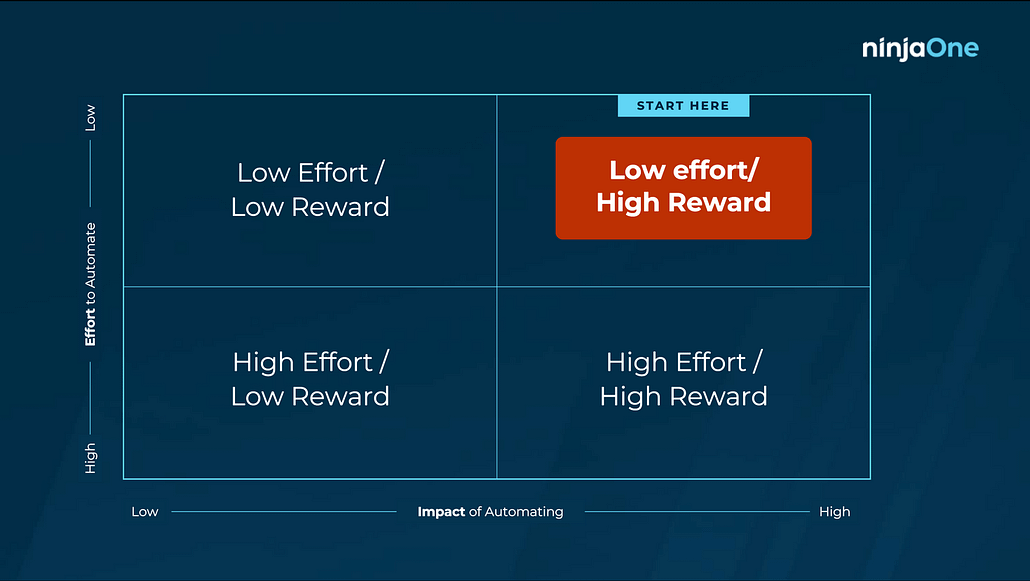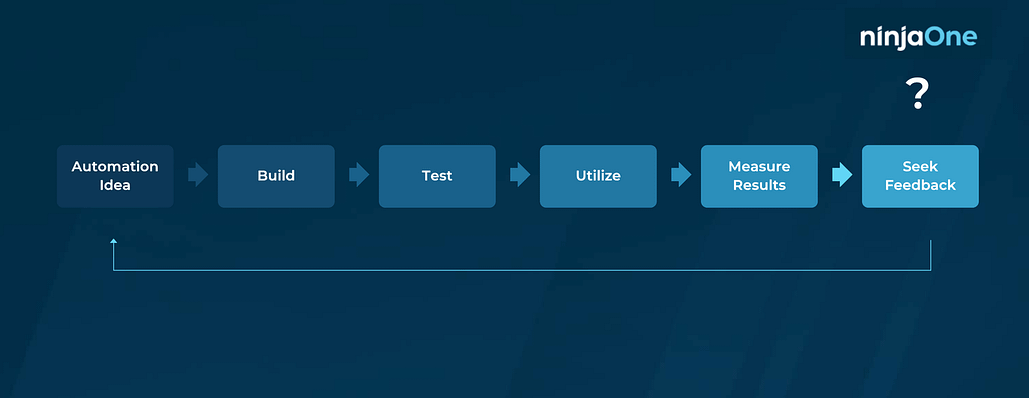Key points
- Why adopting an automation mindset matters
- Boosts productivity
- Reduces costs
- Enables scalability
- Improves accuracy by eliminating human error
- Challenges of adopting an automation mindset:
- Resistance to change
- Knowledge gaps
- Initial set-up costs
- 5-step automation action plan
- Assessment: Pinpoont recurring, high-impact tasks.
- Tool selection: Select automation tools with flexibility and pre-built scripts.
- Training: Train IT staff through workshops and education.
- Implementation: Start with a pilot project, gather feedback, and adapt.
- Review and iterate: Review automation performance and continuously optimize as needed.
Adopting an automation mindset is not merely a trend, but a paradigm shift in how we approach IT processes. In today’s fast-paced digital world, IT process automation stands as a beacon of efficiency and innovation.
Keep reading to understand the critical role of IT automation. We’ll highlight potential challenges and offer preparation tips before fully automating your IT processes. At the end of this blog, we’ll give you a systematic plan to successfully adopt an automation mindset.
Reduce manual workloads and maximize efficiency by automating repetitive task.
Why is IT automation important?
1. Efficiency and productivity boost
Adopting an automation mindset dramatically reduces the time spent on routine tasks. IT process automation enables IT professionals to allocate their time and energy towards more complex, value-added activities. This boost in productivity can lead to faster project completion and improved service delivery.
2. Cost-effective
While there may be an initial learning curve, automation leads to considerable cost savings in the long run, especially when leveraging existing tech stacks. Automated systems can reduce operational costs by minimizing errors and expediting task execution.
3. Scalability
As businesses expand, their operations become more intricate. Automation allows companies to scale without a direct proportional increase in IT resources.
4. Enhanced accuracy
Humans are prone to errors, especially with repetitive tasks. Automated processes ensure consistency, reducing the risk of mistakes.

Learn how Maisons du Monde seamlessly transitioned to remote working by leveraging advanced IT solutions, ensuring uninterrupted business operations.
“Thanks to NinjaOne’s powerful scripting engine, I have the possibility to automate various tasks using custom scripts available in several languages (Powershell, Batch, Javascript, ShellScript and VBScript) on Windows, Mac and Linux operating systems. The customizable settings allow me to create scripts once and schedule their execution according to my needs.”
Fabrice Abida, Lead Endpoint User of Maisons du Monde
Overcoming roadblocks to automation
Despite its many advantages, you might have to deal with a few challenges when adopting an automation mindset.
1. Resistance to change
There’s a common fear among employees that automation might replace their roles. Ensuring transparent communication and emphasizing that automation complements human skills, rather than replacing them, can mitigate these concerns.
2. Knowledge gaps
While the tech-savvy user may easily grasp the nuances of automation, others might find it overwhelming, particularly when automation involves the use of scripts written in PowerShell or other languages. Investing in training and workshops can address this disparity.
3. Initial setup costs
The upfront costs, including new tool investments and training, that come with automation can seem daunting. However, when you have a well-defined ROI projection, these investments become justifiable. It’s equally crucial to gain management buy-in for the process.
Things to know before starting your automation journey
1. Thorough process understanding
Before introducing automation, one must understand the processes in depth. This involves mapping out every step, recognizing bottlenecks, and identifying areas ripe for automation.
2. Know how you will measure success
Along with securing the resources to undertake an automation effort, make sure it is crystal clear how success will be measured and ensure the metrics are in place to report on those.
3. Choosing the right tools
The market is inundated with automation tools. Researching and selecting tools that align with your organization’s specific needs is crucial.
4. The human touch
Automation is not a replacement for human intellect. Striking a balance between automated processes and human intervention is key for optimal results.
Automation action plan
1. Assessment
Assess and pinpoint processes ripe for automation by categorizing recurring support tickets. It’s advisable to commence with straightforward but common tasks, such as password resets, application deployments, and device enrollment and provisioning, to secure a swift automation victory.
2. Tool selection
Based on your needs and budget, select the ideal automation tools tailored to your specific requirements and budget. Prioritize automation solutions that offer readily usable tools and scripts. Opt for systems that support multiple scripting languages, providing flexibility in script creation and reducing dependence on specific skillsets among your staff.
3. Training
Equip your team with the necessary skills through training sessions. This could be done informally, by a senior engineer holding sessions for more junior team members, or reimbursing technicians for technical education.
4. Implementation
Begin with a focused pilot project to test your chosen automation tools in a controlled environment. Select a process that has clear steps and measurable outcomes, such as patch deployment or software updates. Monitor your automated tasks and make necessary adjustments b.efore expanding your workflow automations to more complex tasks.
5. Review and iterate
Regularly review the automated processes and make updates as needed. Document your automated workflows, monitor performance, and try to implement feedback from end-users and your team. Use these insights to refine your approach.

Automate management of your hardware and software.
Conclusion
Adopting an automation mindset means taking a proactive approach to IT processes, with automation at its core. By understanding the importance of IT process automation for improving IT efficiency, learning how to address automation and follow a structured plan, organizations can harness the full potential of automation. Remember, the goal is not to replace the human element but to enhance it.







